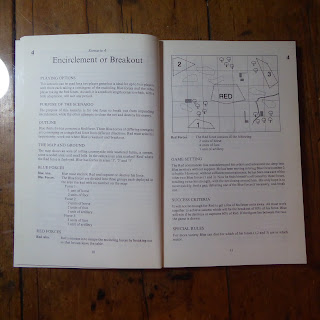Having set up the situation for the second battle of my 'Soldier King' campaign in the previous post, it's an interesting challenge to work out a tabletop scenario.
 |
| All (red ) roads lead to Rahden - and battle |
The issues are that (i) the forces are radically unequal, (ii) I'm not sure I have enough figures to represent them all on one table, and if I have, (iii) I'm not sure I will have space for them all on my three feet square table. So I've been thinking a bit about how to represent the forces and produce an interesting ( and hopefully not too one-sided) game. The thing to avoid, it strikes me, is having the heavily outnumbered Austrians just dug in at the town, being ground down by frontal assaults from their attackers. It's a nice problem to have, of course, and not least because it has sent me to look in some grand old books and publications.
The simplest option is a basic one-off battle scenario, and I found something that looked relevant in Grant and Asquith's 'Scenarios for All Ages' - entitled 'Encirclement or Breakout'.
 |
| from the masters of scenarios |
On a single table , 'Red' is stuck in the middle, with no less than three 'Blue' forces of varying strengths closing in from various directions. Very conveniently, I have an Austrian army in Rahden, with three Prussian contingents converging on them by separate roads. In the scenario, the Red objective to escape, getting his units off the table - and perhaps this is the best hope for the Austrians in Rahden. Can they find the weakest of the surrounding forces and brush it aside, thus escaping? Can Blue close the net around them, and capture a good proportion? So, a potentially useful scenario - though conditions (ii) and (iii) may not be met very easily, given my resources of figures and space. I think Charles Grant and Stuart Asquith assumed a fairly large table and plentiful troops for their setups! Also, with such a disparity between the two armies, in a small space there might not be much scope for finding that crucial gap.. but it's worth considering.
I think perhaps a better bet, though, is some sort of 'mini-campaign' arrangement, with a map area that encompasses several 'tables-worth' of country with the town at the centre, and the Prussian forces arriving at different times on their respective roads, giving the Austrians the possibility of fighting them 'in detail' in more equal combats, while trying not to be worn down by repeated battles. A smaller version of the King Harold's 1066 situation, perhaps? General inspiration for this comes from Donald Featherstone's War Game Campaigns - he clearly loved the map-to-table translation of action. I think I acquired the John Curry re-print first, but then found the original at Salute or SELWG the other year and couldn't resist. Anyway, great for getting the ideas going.
 |
| So good, I bought it twice |
Finally, one of those lovely series of magazine articles from the old days that never quite gets 'archived' from the mental files system. In this case, George Gush's 'One-Day Wargame Campaigns', which turns out to have been the first proper article in the first issue of 'Miniature Wargames', back in , was it 1983?
 |
| Issue no. 1, article no. 1 - not a bad start.. |
Really aimed at big club games involving multiple players, a large space and as many figures as possible, so not quite appropriate here! I think I thought of it because of the mulitple-table aspects. Anyway, it gave me a very pleasant hour's reading on a grey winter's day, and those games must have been great fun. George Gush was an early hero, from his Airfix ECW guide, WRG Renaissance period rules, and his 'Renaissance Armies', which I still have ( sporting a 'Fourth Form Prize' label inside the cover, it was a long time ago! ) - and of course he gave me the title of this blog. Is George still with us, does anyone know?
All the above is of course a way of saying 'I haven't set up the battle yet', but ideas are being mulled over..which is all part of the fun. Keep safe, and well, everyone.







